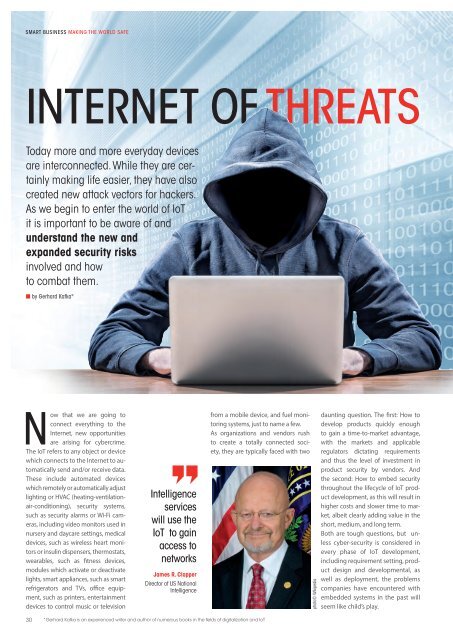Smart Industry 1/2016
Smart Industry 1/2016 - The IoT Business Magazine - powered by Avnet Silica
Smart Industry 1/2016 - The IoT Business Magazine - powered by Avnet Silica
You also want an ePaper? Increase the reach of your titles
YUMPU automatically turns print PDFs into web optimized ePapers that Google loves.
<strong>Smart</strong> Business Making the world safe<br />
Internet of Threats<br />
Today more and more everyday devices<br />
are interconnected. While they are certainly<br />
making life easier, they have also<br />
created new attack vectors for hackers.<br />
As we begin to enter the world of IoT<br />
it is important to be aware of and<br />
understand the new and<br />
expanded security risks<br />
involved and how<br />
to combat them.<br />
■ by Gerhard Kafka*<br />
Now that we are going to<br />
connect everything to the<br />
Internet, new opportunities<br />
are arising for cybercrime.<br />
The IoT refers to any object or device<br />
which connects to the Internet to automatically<br />
send and/or receive data.<br />
These include automated devices<br />
which remotely or automatically adjust<br />
lighting or HVAC (heating-ventilationair-conditioning),<br />
security systems,<br />
such as security alarms or Wi-Fi cameras,<br />
including video monitors used in<br />
nursery and daycare settings, medical<br />
devices, such as wireless heart monitors<br />
or insulin dispensers, thermostats,<br />
wearables, such as fitness devices,<br />
modules which activate or deactivate<br />
lights, smart appliances, such as smart<br />
refrigerators and TVs, office equipment,<br />
such as printers, entertainment<br />
devices to control music or television<br />
Intelligence<br />
services<br />
will use the<br />
IoT to gain<br />
access to<br />
networks<br />
James R. Clapper<br />
Director of US National<br />
Intelligence<br />
from a mobile device, and fuel monitoring<br />
systems, just to name a few.<br />
As organizations and vendors rush<br />
to create a totally connected society,<br />
they are typically faced with two<br />
photo©: Wikipedia<br />
daunting question. The first: How to<br />
develop products quickly enough<br />
to gain a time-to-market advantage,<br />
with the markets and applicable<br />
regulators dictating requirements<br />
and thus the level of investment in<br />
product security by vendors. And<br />
the second: How to embed security<br />
throughout the lifecycle of IoT product<br />
development, as this will result in<br />
higher costs and slower time to market,<br />
albeit clearly adding value in the<br />
short, medium, and long term.<br />
Both are tough questions, but unless<br />
cyber-security is considered in<br />
every phase of IoT development,<br />
including requirement setting, product<br />
design and developmental, as<br />
well as deployment, the problems<br />
companies have encountered with<br />
embedded systems in the past will<br />
seem like child’s play.<br />
30<br />
*Gerhard Kafka is an experienced writer and author of numerous books in the fields of digitalization and IoT

















